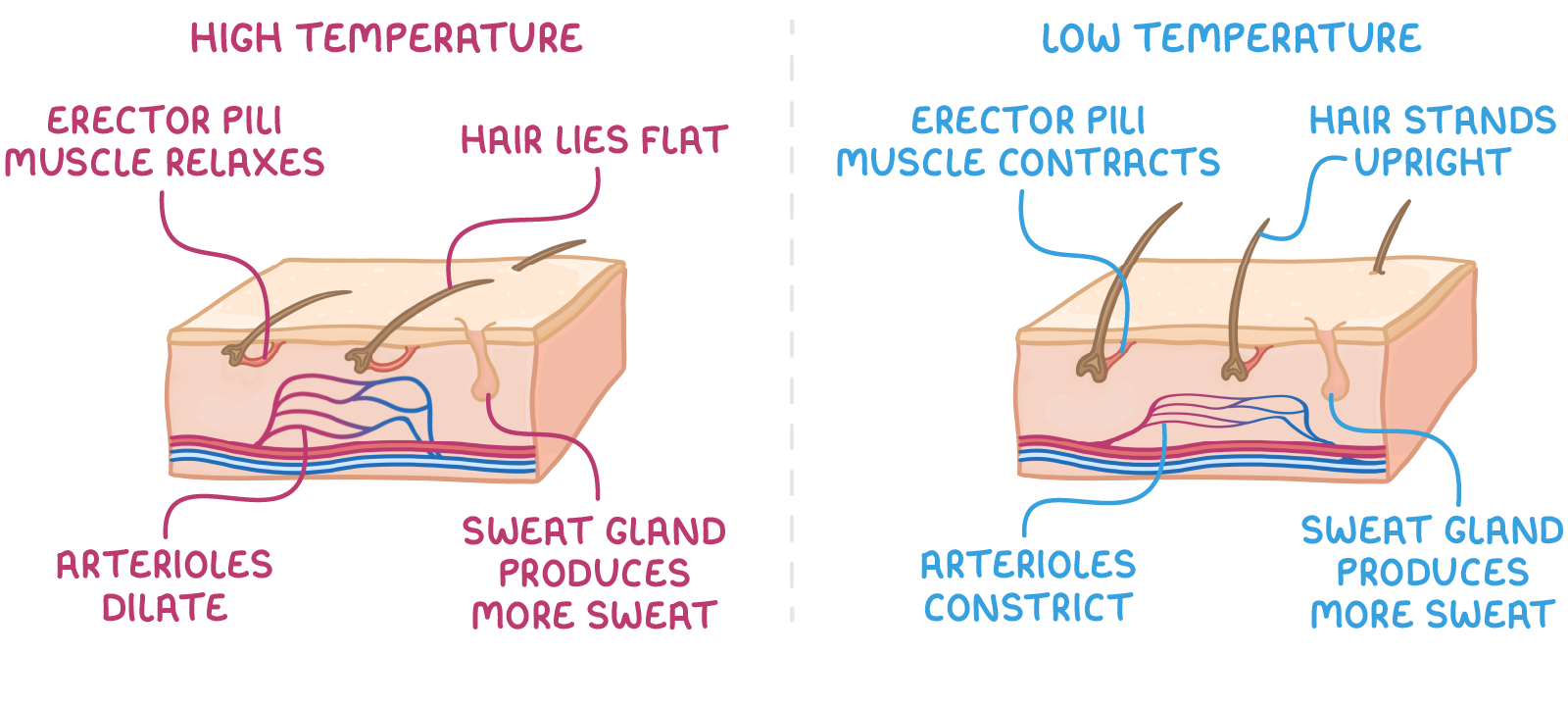Thermoregulation
This lesson covers:
- Temperature control in ectotherms and endotherms
- Mechanisms to decrease or increase body temperature in mammals
- The role of the hypothalamus in controlling body temperature
What is thermoregulation?
Thermoregulation is the process of maintaining a relatively constant core body temperature. This is important to maintain optimum enzyme activity.
Ectotherms and endotherms
Animals use diverse strategies to regulate their internal temperature depending on whether they are ectotherms or endotherms.
| Ectotherms | Endotherms | |
|---|---|---|
| Examples | Reptiles, fish | Mammals, birds |
| Definition | Animals that use their surroundings to regulate their body temperature | Animals that rely on their metabolic processes to control their body temperature |
| Control of body temperature | Can only regulate body temperature through behavioural changes like basking in the sun or seeking shade | Regulate body temperature through internal processes and behavioural changes |
| Variation in body temperature | Internal temperature is influenced by environmental temperatures | Internal temperature is relatively stable and less influenced by changes in environmental temperature |
| Activity level | Activity increases with warmer environmental temperatures and decreases when it's cooler | Can remain active across a range of temperatures |
| Metabolic rate | Metabolic rate varies and the organism generally produces minimal heat on its own | The organism sustains a high and steady metabolic rate, producing large amounts of heat through metabolism |
Mechanisms of thermoregulation in mammals
Mammals have developed a variety of mechanisms to precisely regulate their body temperature.

To reduce body temperature when it is too high:
- Increased sweating - Effector sweat glands produce more sweat to promote evaporative cooling.
- Flattening hair - Effector erector pili muscles relax, flattening hairs and reducing insulation.
- Vasodilation - Effector arterioles near the skin dilate, increasing blood flow to the skin and heat radiation from the skin surface.
To increase body temperature when it is too low:
- Shivering - Effector skeletal muscles contract to generate heat through increased cellular respiration, an exothermic reaction.
- Minimising sweating - Effector sweat glands produce less sweat, which helps to conserve body heat.
- Erecting hair - Effector erector pili muscles contract, raising hairs, trapping a layer of warm air, and increasing insulation.
- Vasoconstriction - Effector arterioles near the skin constrict, reducing blood flow to the skin and heat radiation from the skin surface.
- Releasing adrenaline and thyroxine - Effector glands release these hormones to speed up cellular metabolism, which produces more heat.
The role of the hypothalamus in controlling body temperature
The hypothalamus is the thermostat of the brain, and is crucial in coordinating thermoregulation in mammals.
It does this as follows:
- The hypothalamus collects information about core body temperature from temperature receptors in the hypothalamus and about surface temperature from peripheral receptors in the skin.
- This information is processed in the hypothalamus to detect deviations from normal levels in core and surface body temperature.
- The hypothalamus then sends signals to effectors like muscles and sweat glands.
- These effectors implement mechanisms to restore the ideal temperature.
This homeostatic process lets mammals maintain a stable internal temperature, even when external temperatures fluctuate.
The heat loss and heat gain centres in the hypothalamus
The two control centres involved in thermoregulation are the heat loss centre and the heat gain centre.
When blood temperature increases:
- Impulses are sent to the heat loss centre in the hypothalamus.
- This sends impulses to the effector organs to increase heat loss.
- The body temperature returns to the optimum point.
When blood temperature decreases:
- Impulses are sent to the heat gain centre in the hypothalamus.
- This sends impulses to effector organs to reduce heat loss.
- The body temperature returns to the optimum point.